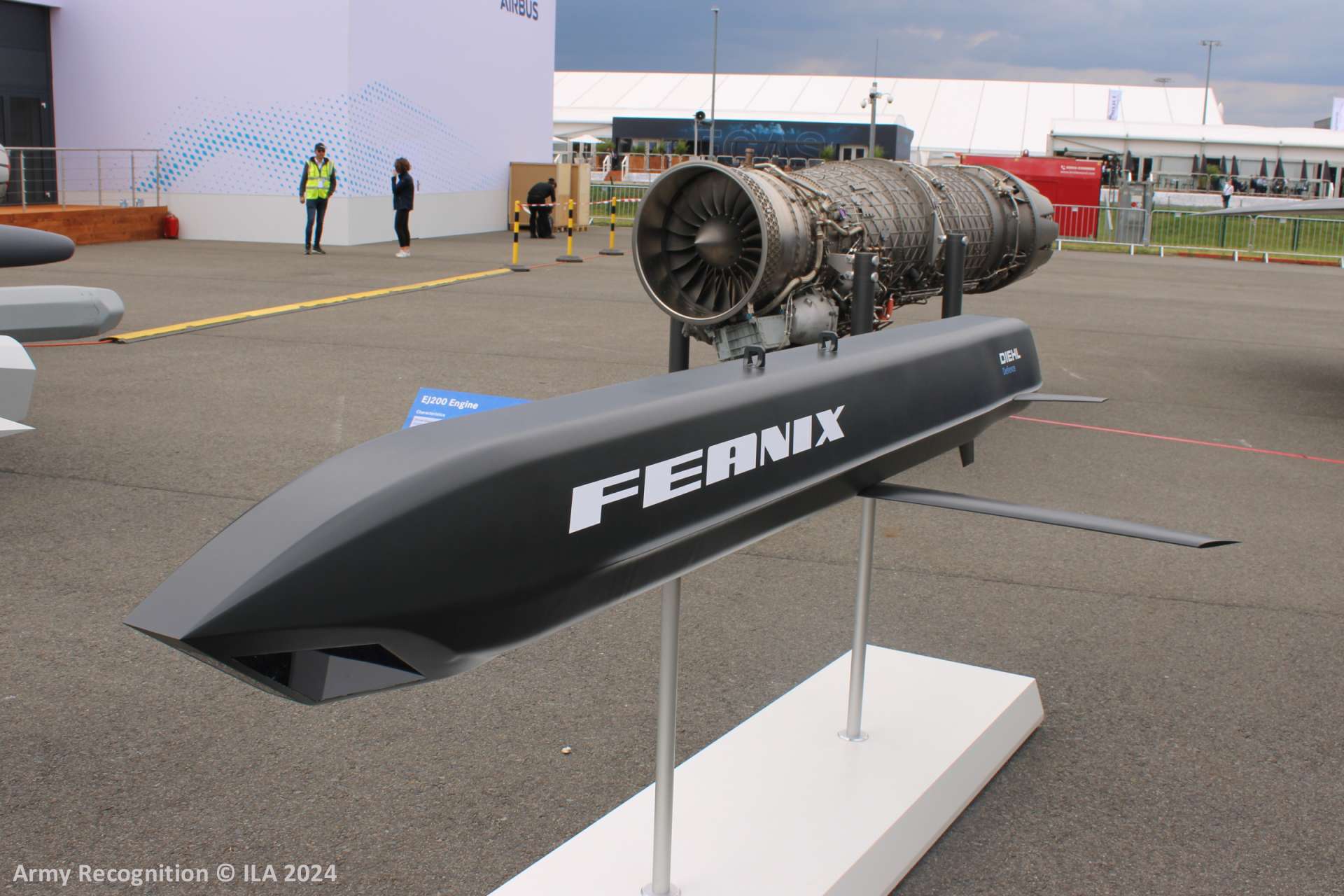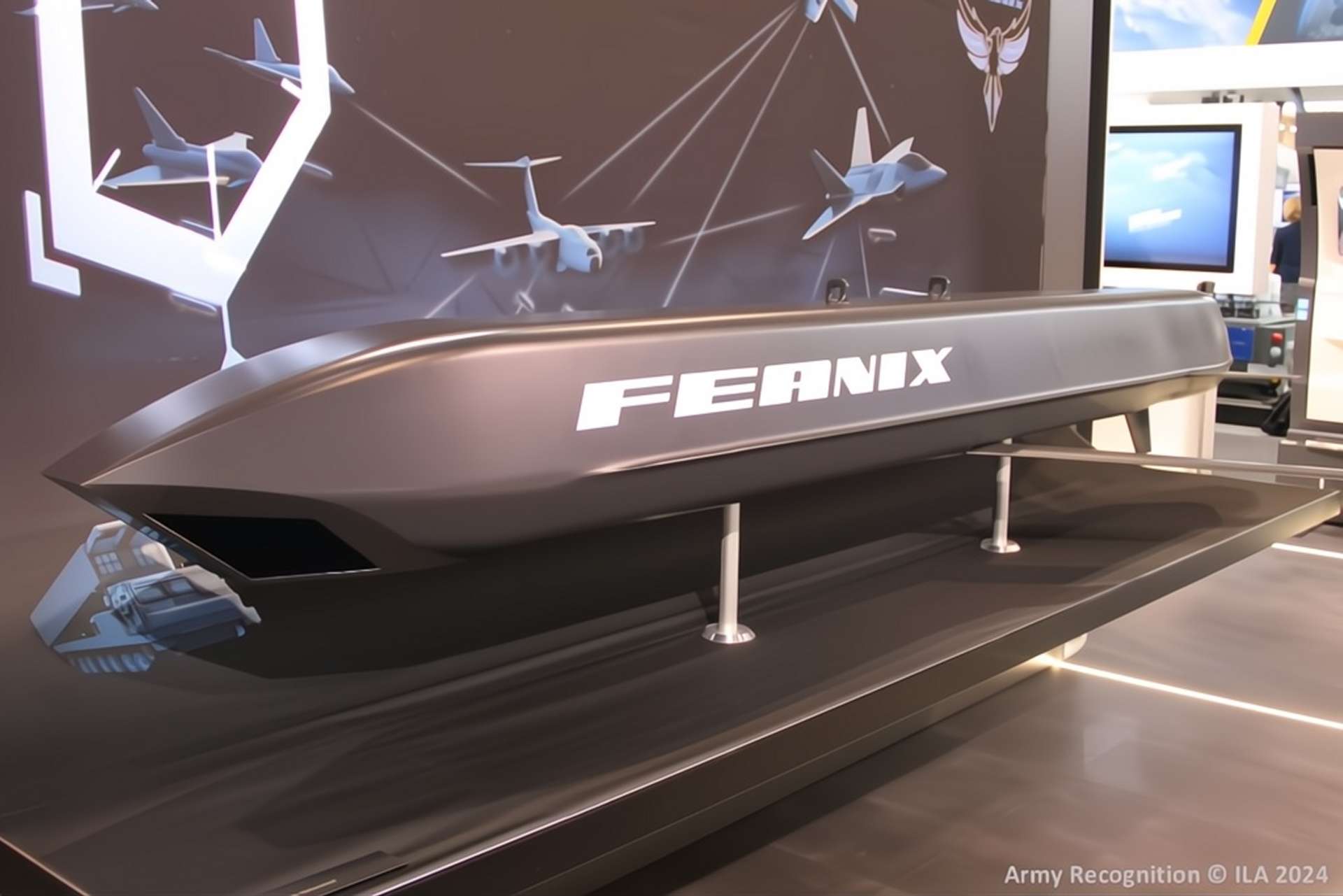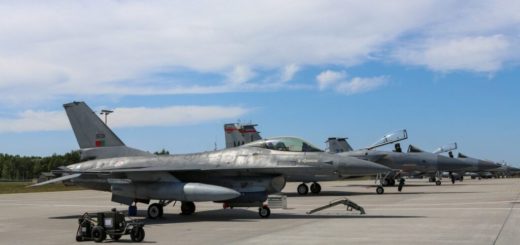ILA 2024: Diehl Defence unveils new FEANIX remote carrier to support next-gen fighter jets

{loadposition bannertop}
Breaking news
{loadposition sidebarpub}
During the ILA 2024 Berlin Air Show, held from June 5 to 9, the German company Diehl Defence presented a model of a new remote carrier named FEANIX, which stands for Future Effector – Adaptable, Networked, Intelligent, Xpendable. The FEANIX is intended to work alongside the pan-European Future Combat Air System (FCAS) next-generation air combat program, the Airbus Loyal Wingman concept, and the current Eurofighter Typhoon.Follow Army Recognition on Google News at this link
The FEANIX is intended to work alongside aircraft such as the pan-European Future Combat Air System (FCAS) next-generation air combat program, the Airbus Loyal Wingman concept, and the current Eurofighter Typhoon. (Picture source: Army Recognition)
Alexander Brugger, project lead for the FEANIX at Diehl Defence, stated that the turbojet-powered FEANIX will fly at subsonic speeds with a maximum range of around 480 kilometers, similar to the German Taurus KEPD 350 cruise missile. However, the range will depend on the flight profile and launch parameters. Diehl categorizes the FEANIX as a Light Remote Carrier (LRC), part of a series of connected platforms envisioned to work alongside crewed New Generation Fighters (NGF) as part of the pan-European FCAS.
Remote carriers have long been a core part of the FCAS next-generation fighter program and are expected to perform a range of missions while keeping manned platforms further from enemy range. Notably, Diehl Defence is part of the FCAS Future Combat Mission System (FCMS) industrial consortium, which aims to engineer networked sensor and effector systems for joint and combined operations. Brugger emphasized that the FEANIX’s development is not restricted by the FCAS, allowing Diehl to progress independently, invest in self-financed research and development activities focused on Remote Carriers in the missile systems field, particularly in the lightweight class, advance the LRC operational concept, expand its product portfolio, and address an identified capability gap in the armed forces.
During the Berlin Air Show, Diehl Defence announced ongoing discussions with the German Armed Forces regarding the further development and funding of the FEANIX concept. Project lead Alexander Brugger indicated optimism about reaching an agreement this year. Although the German Armed Forces did not confirm these talks, they acknowledged continuous communication with the industry regarding potential defense developments.
Due to its modularity, the FEANIX platform will allow for the integration of different payloads, ranging from sensors to lethal and non-lethal effectors, depending on the specific mission requirements. (Picture source: Army Recognition)
Different sizes and capabilities are planned for these FEANIX LRCs. Due to this modularity, the FEANIX platform will allow for the integration of different payloads, ranging from sensors to lethal and non-lethal effectors, depending on the specific mission requirements. Brugger mentioned that the development program is expected to begin in the early 2030s, with Diehl having self-funded the initial design phase. A testbed platform is planned for development by around 2028, with a prototype to be built at Diehl’s Uberlingen facility. The goal is to develop the operational product by 2030, well before the projected FCAS realization period of 2040 and beyond.
Designed to be a long-range effector that can be used in multi-domain operations (MDO) across land, air, sea, and cyber domains, the FEANIX will be less than 4 meters long, although a placard displayed alongside a full-scale mockup at ILA 2024 indicated it would be less than 3.5 meters long. In both cases, it is designed to weigh less than 300 kilograms. The design emphasizes low observability, featuring a chine-line that wraps around the edge of the weapon and a faceted nose with three windows for infrared and/or electro-optical sensors. It also has pop-out wings fitted below the body and tail surfaces comprising a single ventral fin and a pair of horizontal stabilizers.
The front section of the FEANIX can be equipped with a warhead, jammer, or other payloads, while the body is fitted with an air-breathable engine. Brugger highlighted several operational priorities for the FEANIX, such as Suppression of Enemy Air Defense (SEAD) and Destruction of Enemy Air Defenses (DEAD). A network of five or six remote carriers can form a team to enhance effectiveness through combined data networking and swarming capabilities, aiming for the FEANIX to operate highly automated and independently of its carrier system, although specific details on achieving these autonomy levels were not provided.

{loadposition bannertop}
Breaking news
{loadposition sidebarpub}
During the ILA 2024 Berlin Air Show, held from June 5 to 9, the German company Diehl Defence presented a model of a new remote carrier named FEANIX, which stands for Future Effector – Adaptable, Networked, Intelligent, Xpendable. The FEANIX is intended to work alongside the pan-European Future Combat Air System (FCAS) next-generation air combat program, the Airbus Loyal Wingman concept, and the current Eurofighter Typhoon.
Follow Army Recognition on Google News at this link
The FEANIX is intended to work alongside aircraft such as the pan-European Future Combat Air System (FCAS) next-generation air combat program, the Airbus Loyal Wingman concept, and the current Eurofighter Typhoon. (Picture source: Army Recognition)
Alexander Brugger, project lead for the FEANIX at Diehl Defence, stated that the turbojet-powered FEANIX will fly at subsonic speeds with a maximum range of around 480 kilometers, similar to the German Taurus KEPD 350 cruise missile. However, the range will depend on the flight profile and launch parameters. Diehl categorizes the FEANIX as a Light Remote Carrier (LRC), part of a series of connected platforms envisioned to work alongside crewed New Generation Fighters (NGF) as part of the pan-European FCAS.
Remote carriers have long been a core part of the FCAS next-generation fighter program and are expected to perform a range of missions while keeping manned platforms further from enemy range. Notably, Diehl Defence is part of the FCAS Future Combat Mission System (FCMS) industrial consortium, which aims to engineer networked sensor and effector systems for joint and combined operations. Brugger emphasized that the FEANIX’s development is not restricted by the FCAS, allowing Diehl to progress independently, invest in self-financed research and development activities focused on Remote Carriers in the missile systems field, particularly in the lightweight class, advance the LRC operational concept, expand its product portfolio, and address an identified capability gap in the armed forces.
During the Berlin Air Show, Diehl Defence announced ongoing discussions with the German Armed Forces regarding the further development and funding of the FEANIX concept. Project lead Alexander Brugger indicated optimism about reaching an agreement this year. Although the German Armed Forces did not confirm these talks, they acknowledged continuous communication with the industry regarding potential defense developments.

Due to its modularity, the FEANIX platform will allow for the integration of different payloads, ranging from sensors to lethal and non-lethal effectors, depending on the specific mission requirements. (Picture source: Army Recognition)
Different sizes and capabilities are planned for these FEANIX LRCs. Due to this modularity, the FEANIX platform will allow for the integration of different payloads, ranging from sensors to lethal and non-lethal effectors, depending on the specific mission requirements. Brugger mentioned that the development program is expected to begin in the early 2030s, with Diehl having self-funded the initial design phase. A testbed platform is planned for development by around 2028, with a prototype to be built at Diehl’s Uberlingen facility. The goal is to develop the operational product by 2030, well before the projected FCAS realization period of 2040 and beyond.
Designed to be a long-range effector that can be used in multi-domain operations (MDO) across land, air, sea, and cyber domains, the FEANIX will be less than 4 meters long, although a placard displayed alongside a full-scale mockup at ILA 2024 indicated it would be less than 3.5 meters long. In both cases, it is designed to weigh less than 300 kilograms. The design emphasizes low observability, featuring a chine-line that wraps around the edge of the weapon and a faceted nose with three windows for infrared and/or electro-optical sensors. It also has pop-out wings fitted below the body and tail surfaces comprising a single ventral fin and a pair of horizontal stabilizers.
The front section of the FEANIX can be equipped with a warhead, jammer, or other payloads, while the body is fitted with an air-breathable engine. Brugger highlighted several operational priorities for the FEANIX, such as Suppression of Enemy Air Defense (SEAD) and Destruction of Enemy Air Defenses (DEAD). A network of five or six remote carriers can form a team to enhance effectiveness through combined data networking and swarming capabilities, aiming for the FEANIX to operate highly automated and independently of its carrier system, although specific details on achieving these autonomy levels were not provided.






